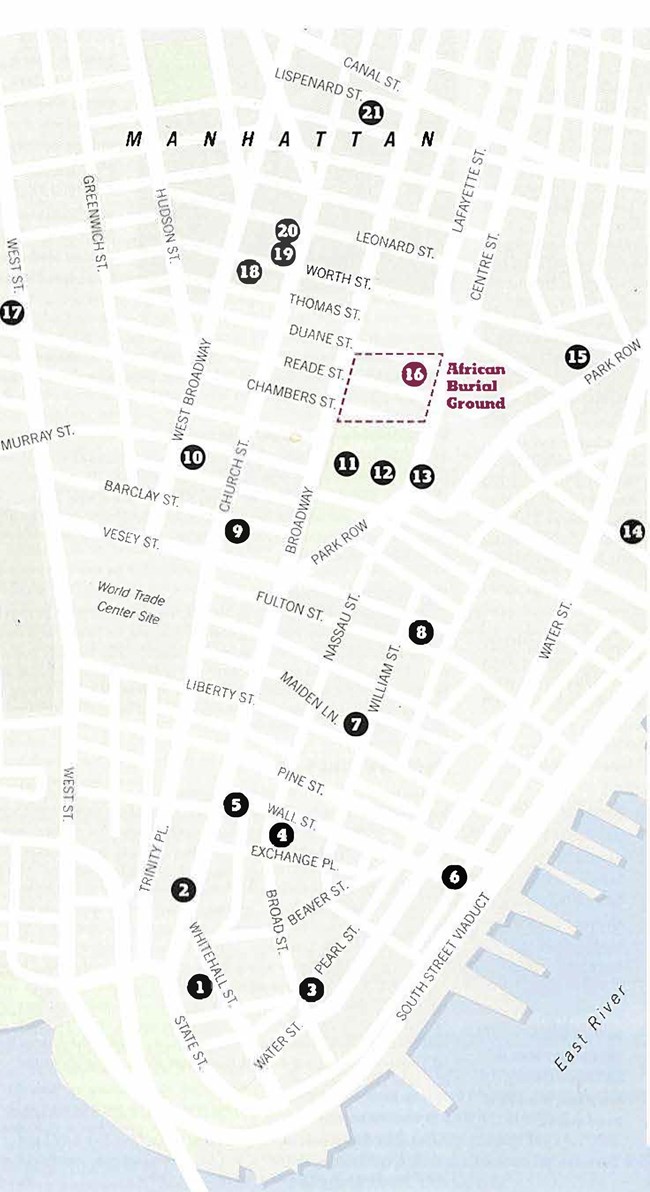
National Park Service In 1625 enslaved Africans arrived in New Amsterdam. Among their first tasks was to build the first fort on Manhattan Island, known as Fort Amsterdam. One Bowling Green (site of the National Museum of the American Indian) 2. Broadway The city’s first municipal work force, enslaved Africans cleared land and shoreline and widened Native American trails, including a wide road later known as Broadway. Broadway 3. Fraunces' Tavern A popular restaurant owned by Samuel Fraunces, a West Indian caterer of French and African origin. Site of General George Washington's farewell address to his troops in 1783. 54 Pearl Street 4. Downing's Oyster House Popular restaurant in the early 1800s owned by black abolitionist Thomas Downing. Its cellar served as a stop on the Underground Railroad. 5. The Wall Enslaved Africans constructed a wall across Manhattan Island in 1653. Extending from the Hudson River to the East River, it is later known as Wall Street. Wall Street 6. Wall Street Slave Market Established in 1711 at a pier at Wall Street and the East River, African men, women, and children were sold at the Wall Street Slave Market. Corner of Wall Street and Front Street 7. 1712 Slave Revolt A group of enslaved Africans ambushed whites on the outskirts of the city in 1712. Nineteen blacks were executed in response to the slave uprising. Northwest corner of Maiden Lane and William Street 8. African Free School Founded in 1787 in a single room for forty boys and girls. 245 William Street (between Ann Street and Fulton Street) 9. St. Peter’s Church Destroyed by fire in 1835, the church was rebuilt chiefly from money given by Pierre Toussaint, a former slave and Haitian philanthropist. 22 Barclay Street (southeast corner of Church Street and Barclay Street) 10. Dr. James McCune Smith A graduate of the African Free School, Dr. Smith established a medical practice and pharmacy here in 1837. 55 West Broadway (between Murray Street and Park Place) 11. Pinkster Celebration In the 17th century, the Afro-Dutch community celebrated an African ceremony called Pinkster at this site. The annual celebration coincided with the Christian observance of Pentecost. City Hall Park 12. 1741 Executions A rumor of a slave uprising in New York City led to the trial and convictions of thirty-five defendants. All were executed, either by hanging or burning, including thirty-one black men, two white men, and two white women. City Hall Park 13. Road to Harlem In 1658, African workers built the road to Harlem (later known as the Boston Post Road). Park Row (to 110th Street and the East River) 14. 1863 Draft Riots During four days of citywide violence in July 1863, the homes of African Americans and abolitionists were firebombed. Estimates range from 100 to more than 1,000 people killed, including two men, Abraham Franklin and Jeremiah Robinson, on Roosevelt Street. Roosevelt Street (between Cherry Street and Oak Street) 15. Land of the Blacks From 1643 to 1712, more than thirty farms owned by free blacks spanned the frontier north of the African Burial Ground to 34th Street. Chinatown, SoHo, Greenwich Village, Little Italy 16. African Burial Ground Memorial Site An estimated 20,000 men, women, and children were buried in the cemetery here from the late 17th century until it was closed in 1795. Approximately five city blocks, the site was five to six acres in size. Duane and Elk streets 17. Frederick Douglass The Hudson River pier where Frederick Washington Bailey, a runaway slave from Maryland, came ashore in 1838. Aided by the Underground Railroad, Bailey achieved freedom and renamed himself Frederick Douglass. Chambers and West streets (site of Stuyvesant High School) 18. Abyssinian Baptist Church Founded in 1808 by black members of the First Baptist Church. 40 Wall Street 19. Mother A.M.E. Zion Church The first African-American church in New York City, founded in 1796. 156 Church Street 20. Freedom’s Journal 21. Ruggles' Boarding House Rooming house for blacks owned by black abolitionist David Ruggles, and an Underground Railroad station that assisted hundreds of fugitives, including Frederick Douglass. (Ruggles' first boarding house was located at 67 Lispenard Street.) 36 Lispenard Street |
Last updated: June 20, 2022
